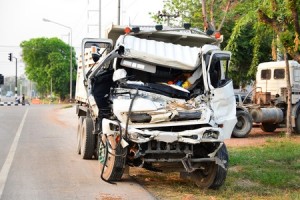
Truck accidents can be among the most damaging kind of traffic collisions. They happen on U.S. roads and highways every day. According to National Highway Traffic Safety Administration statistics, accidents involving large trucks killed 3,757 people in 2011, and injured 88,000 more that same year.
Tractor-trailers and other large commercial trucks are much larger and weigh more than passenger cars. Add highway speeds, a heavy load of cargo, and a truck driver’s momentary inattention or mistake can cause pileups and multi-vehicle accidents resulting in serious injury or loss of life.
While some of these crashes cause minor injury, many other accidents involving 18 wheelers cause severe, long-term injuries, catastrophic injuries and even death. Back and neck injuries are some of the most common injuries sustained in motor vehicle crashes generally. These can range from whiplash and other soft tissue injuries to bulging discs, herniated discs, spinal fractures, partial or complete spinal cord injuries and other back and neck injuries. Some other truck accident injuries include head injuries, brain injuries, injuries to joints like shoulders or knees, internal organ damage, broken bones, cuts and bruises, burn injuries, and crush injuries. In some cases, such injuries may not immediately or easily be apparent or visible.
Potential damages in truck accidents can be either economic or non-economic in nature. Economic truck accident damages compensate the victim and the victim’s family for monetary losses, while non-economic damages compensate the victim and the victim’s family for intangible and non-financial losses. In some cases, punitive damages may also be available.
 Examples of economic damages include current and future medical expenses, which include fees for hospital care, emergency room visits, surgery, assistive devices, and extended medical care and attention. Other common economic damages are lost wages and reduced earning capacity. A victim may be compensated for reduced earning capacity if it can be proven that his or her ability to earn a living has been reduced or limited by the accident.
Examples of economic damages include current and future medical expenses, which include fees for hospital care, emergency room visits, surgery, assistive devices, and extended medical care and attention. Other common economic damages are lost wages and reduced earning capacity. A victim may be compensated for reduced earning capacity if it can be proven that his or her ability to earn a living has been reduced or limited by the accident.
Examples of non-economic damages are pain and suffering, mental anguish, and loss of consortium. Pain and suffering refers to the physical pain suffered by the victim as a result of his or her accident-related injuries. If the accident results in fatality, then the decedent’s loved one may be compensated for lifetime financial support and other losses. An experienced 18 wheeler wreck lawyer can help you identify and document the damages caused by your truck accident.
 Depending on local law, punitive damages may be available when the defendant’s actions that caused the injury were intentional, malicious, reckless, or wanton in nature. This type of damage aims to punish the offender and discourage similar behavior.
Depending on local law, punitive damages may be available when the defendant’s actions that caused the injury were intentional, malicious, reckless, or wanton in nature. This type of damage aims to punish the offender and discourage similar behavior.
Properly valuing value a truck accident claim can be difficult, particularly when something like “pain and suffering” is involved. Some factors considered may include: the severity of and permanency of injuries, extent of pain, suffering and disability, past and future medical expenses and lost income, relative fault of the parties involved, degree and extent of loss, available evidence and resources and the facts and circumstances of the case.
If you or someone you love is seriously injured, disabled, or killed in a truck accident, call Flick Law Firm as soon as possible.










